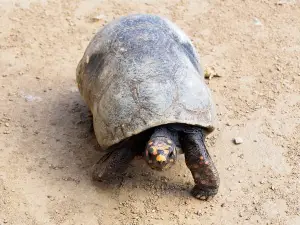
If your tortoise’s skin suddenly changes you may think that the little fella has some sort of disease like skin rot. This article looks into skin rot in tortoises.
Table of Contents
Tortoise skin rot:
If your pet tortoise starts looking, or acting, strangely you’d likely start to worry and you may think that your pet has skin rot.
Here is what you need to know about tortoises and skin rot:
Appearance:
If your little reptile’s skin starts looking, and smelling, as though it is rotting then the animal may have shell rot and this shell rot may be affecting your pet’s skin.
When a tortoise develops shell rot not only will the animal’s shell be affected, but a rotting of the skin can also develop.
Shell rot causes the scutes of your pet’s shell to fall off. The scutes are the hard scales that make up the shell.
If this condition is allowed to advance then the scutes will start to fall off and your pet will start to suffer from a variety of other issues.
Other issues include the rotting of the skin under the shell. The rotting skin under the shell will be exposed once the scutes fall off.
Causes of this condition in your pet include the animal living in an unclean environment which can lead to bacterial growth, damage to the animal’s shell which can lead to a bacterial infection, or an environment that is too dry which can lead to the animal’s shell cracking.
Other signs of skin rot:
In addition to the change in the appearance of your pet’s skin, a tortoise with skin rot will also start to show signs of distress.
The signs of distress that you may see along with the rot on your pet’s skin include cracks in the shell, pimpling or dimpling of the shell, an unpleasant discharge coming from the shell, scutes that are falling off, and lifting scutes.
What to do:
If your pet’s shell rot has become so severe that the animal’s scutes fall off then you’d need to get your pet to the vet.
Your vet will likely prescribe antibiotics for your pet, or, suggest that your tortoise stay overnight until the animal recovers.
If the shell rot is not advanced yet, and you catch it early, then what you’d need to do is vigorously clean the shell with a chlorhexidine solution.
Use a soft bristle brush to rub the shell. Let the shell dry and allow fresh air to circulate after the cleaning.
How to prevent shell rot:
Prevention is better than cure when it comes to tortoises and sell rot. You can keep this condition from developing in your beloved pet by:
- Making sure that surfaces are disinfected monthly
- Giving your pet fresh water daily
- Cleaning your pet’s water dish daily
- Doing a monthly cleaning out and replacing of substrates
- Cleaning feces and urates daily
If you enjoyed this article then you may also be interested in other turtle/tortoise related articles. Here are some articles that you may be interested in: Why Does My Tortoise Keep Hitting The Glass?, Why Is My Tortoise So Active At Night?, White Spots On Turtle Head, Turtle With White Spots On Head, White Spots On Turtle Feet, Can A Tortoise Go Into Shock?, Why Does My Turtle Follow Me?, Turtle Biting Shell, Why Is My Turtle Biting Everything?

